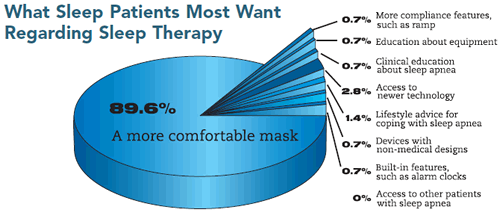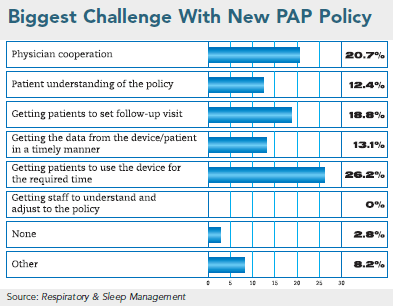Products & Technology
Getting a Sound Sleep
As OSA awareness grows, so does the market for CPAP services, but treatment compliance is an issue. How can HMEs help?
- By David Kopf
- Jan 01, 2010
 More than 18 million Americans suffer from obstructive sleep apnea, and an estimated 85 percent of them go undiagnosed for years. The sleep disorder takes its name from the Greek word apnea, meaning “without breath,” and oftentimes during the night, people suffering from sleep apnea will stop breathing repeatedly for a minute or longer, as well as hundreds of times in a single night.
More than 18 million Americans suffer from obstructive sleep apnea, and an estimated 85 percent of them go undiagnosed for years. The sleep disorder takes its name from the Greek word apnea, meaning “without breath,” and oftentimes during the night, people suffering from sleep apnea will stop breathing repeatedly for a minute or longer, as well as hundreds of times in a single night.
Although the primary risk factor for OSA is excessive weight gain, losing weight might not fully eliminate the disorder. That’s where positive airway pressure therapy comes in. CPAPs, short for continuous positive airway pressure, are the most common airway therapy systems that help people with OSA breathe at night.
Growing Condition, Growing Market
In terms of the market for CPAP services, HMEs expect sleep revenue to grow by 6 percent between Fall 2009 and Fall 2010, according to the Q4 2009 HME Sleep Survey from HME Business and Wells Fargo Securities, LLC have released That expectation was down from 9 percent in our prior Q2 2009 survey, and came after growing at 5 percent (down from 7 percent in our prior survey) in the last 12 months.
HME Business and Wells Fargo Securities conduct the survey twice a year, and the results of the latest and previous surveys are available for download on the HME-busines.com website. The seventh biannual survey included responses from 119 home medical equipment dealers providing sleep collected from Sept.21 to Sept. 24.
In terms of market potential, HMEs said they expect the economy to slow growth by 1.3 percent and home testing to increase growth by 1.4 percent from Fall 2009 to Fall 2010. Based on the results of the survey, we maintain our U.S. sleep market growth forecast of 8 percent to 10 percent constant currency growth.
An important finding was that Increased mask replacement rates and use of compliance tracking are drivers in the sleep market. On average, the HMEs surveyed indicated that sleep patients used 2.1 masks per year in the past 12 months and expect this to increase to 2.2 masks per year in the next 12 months.
While this seems like a small change, Wells Fargo estimates that it could add 5 percent to U.S. mask growth and over 2 percent to U.S. sleep market growth. On average, the HMEs indicated that they used compliance tracking in 67 percent of their sleep patients in the past 12 months and expect this to increase to 74 percent in the next 12 months.

Compliance Requirements
Patient compliance, however, remains an issue with CPAP therapy, and providers need to make sure they select the right CPAP for the patient, as well as other products that will help encourage compliance. This is especially important because the implementation of a new PAP local coverage determination (LCD) in 2008 placed the burden of CPAP compliance on providers. The requirement pushed many providers to seek out new compliance technology and implement new strategies to make sure patients met the requirements for continued coverage.
The first part in tackling that lies in understanding why patients don’t comply. In another exclusive HME Media Group survey conducted by HME Business sister publication Respiratory & Sleep Management in June, RSM surveyed 235 respiratory HME providers and therapists to learn their perspectives on patient compliance, business growth and sleep therapy devices.
When asked to identify the biggest challenge with PAP policy implementation, the majority said getting patients to use the device for the required time was the most challenging. In terms of CPAP treatment compliance, it’s important to note that survey respondents also indicated that sleep patients most want a more comfortable mask when it comes to sleep therapy.
Why Patients Don’t Comply
Understanding why patients don’t comply with treatment is difficult, as no two patients are the same, but there are some commonalities; comfort being a top factor.
“It is difficult to point out a single reason for non-compliance of CPAP therapy,” says Suzanne Debow of Fisher and Paykel Healthcare. “However, clinical studies have suggested that the primary reasons for non-compliance are interface (mask) issues, nasal symptoms, and pressure intolerance.”
“Assuming the patient is adequately educated about the health risks of OSA and the benefits of therapy, the most common reasons for failure to adhere to therapy are discomfort and in ability to tolerate higher pressures,” agrees Kristin Olexa, sleep marketing ,anager, DeVilbiss Healthcare. “Discomfort tends to mostly relate to the physical aspects of wearing an interface — especially when the interface has a poor fit for the patient and they need to wear it very tight in order to eliminate leaks. A feeling of claustrophobia or difficulty breathing can impacts a patients adherence, especially at higher pressures.” “Breathing back against pressure is an unnatural thing and takes some getting used to,” says Kacey Stevenson, BS, RRT, vice-president of business development for evo Medical Solutions. “CPAP therapy is not comfortable. I think we have to make that clear with patients up front.”
But fit is half the battle. Besides physical comfort, patients might not take much comfort emotionally or psychological in the notion that they have OSA and need a CPAP. They might even be surprised to learn that they have a condition.
“I think one of the most important factors is the psychological reasons,” Stevenson says. “And I think that’s what we don’t pay enough attention to. As human beings we have a natural resistance to change. Most patients are in denial that they have a condition.
“A lot of patients are pushed to the physician by their spouse, they go in and are told they have this disease, and they come out thinking ‘they say I have it, but I don’t really feel like I have it, and they want me to wear a CPAP with a mask …,’” he continues. “It just really seems difficult and that they think isn’t worth trying.”
“Motivation can be impacted by things like ‘Boy, I don’t really feel all that bad, so in cases of asymptomatic or mild symptoms there can be a sense of ‘I’m not that sick; this isn’t that big a problem,” says Gretchen Jezerc, director of U.S. marketing for sleep disordered breathing with Philips Respironics.
Additionally, the patient might not understand that the condition is something that has built up over the years and that it is only now an issue, he says. Moreover, it’s complete out of their control, which can be difficult to grasp.
Education Creates Compliance
While their might be a wide range of factors involved in why patients don’t comply with CPAP treatment, a key way that providers can help them comply is education.
“Patient education, a good fitting and comfortable interface, and early intervention to solve problems within the first seven days of therapy are, by far, the most important aspects of helping patients acclimate to therapy,” Olexa says. “Other important elements relate to the device itself. A device that is small, quiet, and looks unobtrusive on the patient’s nightstand is also critical to lessening the disruptive impact of adopting CPAP therapy. For patients that travel, the size of the device and ease with which the patient can take it with them on their travels are important, as well.”
Part of education is managing expectations about treatment and outcomes, Stevenson says. “Make sure that the patient understands that their condition is not an acute disease. They’re not going to feel 100 percent better tomorrow or the following morning. It’s going to take some time.”
“Patients should also comprehend comorbidities he says. HMEs should ensure patients understand “it’s not just about being sleepy,” he says. “There are some severe cardiac complications that arise from the condition. So they need to understand why it should be important to them.”
“I don’t think anybody likes to take a ‘fear of God’ approach [to patient education], but on the flip-side, if patients aren’t adequately educated about the risks of not treating their OSA, then that’s a missed opportunity to have them be motivated about following the therapy,” Jezerc says.
When it comes to patient education, helping patients understand their condition and treatment is a process that all parties involved in the patient’s care must deal with — not just providers.
“Education, also comes from all parties. In the process of diagnosis to treatment for patients with OSA — from the referral source to the HME — patients interact with multiple individuals who play an important role in supporting and educating the patients, which in turn leads the patients towards the ultimate goal of CPAP acceptance,” DeBow says. “Therefore, it is important that these key individuals are fully aware of their roles in the process of supporting and educating the patients. The physician must stress the importance of diagnoses, the lab has the responsibility to build upon the education of the patient and provide a pleasant experience during the sleep study, which includes proper interface fit and appropriate titration.
And the HME is in a key position when it comes to education says Jezerc, because not all parties in the patient’s care might have supplied education. When the patient meets with his or her primary care physician, the information supplied to the patient might be limited as the physician might expect more information to be supplied by the sleep lab. However the sleep lab might be more focused on diagnosing the patient’s condition and the patient’s titration.
“The HME has the opportunity to enhance the patients’ entire experience by furthering education and providing on-going support to the patient,” she continues. “All parties involved in the patients diagnoses and treatment aspects should strive to work together to provide consistent and collaborative support to the patients and each other. The patients’ own motivation as well as external/family support is also critical as they try to adapt to the interface, the CPAP pressure, and the lifestyle changes imposed by the use of CPAP.”
Education also comes down to empowerment, Stevenson says. Patients often feel that they are out of control. They have been told they have a condition and must engage in treatment to do something that all people do: sleep. Suddenly being told they need to do that with a device and doctors and providers involved can be jarring.
“We as manufacturers can make the best equipment possible, and the homecare provider can provide the best education and service, but if the patient doesn’t press the on button; if it’s not important enough for them to do that, then we’re never going to have success with that patient,” Stevenson advices. “Giving them some choice in their therapy and therefore empowering them and letting them know that they are in control and they can control their process will go a long way.”
CPAP Compliance From a Regulatory Perspective
In 2008, a PAP local coverage determination (LCD) placed the burden of CPAP compliance on providers. The requirement pushed many providers to seek out new compliance technology and implement new strategies to make sure patients met the requirements for continued coverage. However, the process has been a struggle.
In a survey conducted by HME Business sister publication Respiratory & Sleep Management in June, RSM surveyed 235 respiratory HME providers and therapists to learn their perspectives on CPAP compliance, business growth and sleep therapy devices. Providers noted various challenges they were finding with the new policy.

This article originally appeared in the January 2010 issue of HME Business.